350 Search Results for aided language input
January 26, 2017
by Carole Zangari -
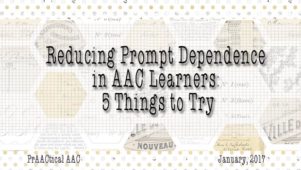
“He knows what to do. He just doesn’t do it.” “He’s prompt-dependent. How can I get him to use AAC on his own?” “I love his strong-willed nature, but it works against him sometimes. He doesn’t initiate.” If any of these remarks sound familiar, it may be time to think about alternative approaches to build independent communication. Here are a few things to try with AAC users who’ve learned to wait for support before communicating. Exaggerate the pause time: Many of our AAC learners need at least 5 seconds of pause time after a communication opportunity presents itself. This helps them process the experience, organize their thoughts, decide on a response, and then begin to execute that response. Sometimes, though, we work with people who’ve learned that if they just wait, the communication partner will start to help (whether or not they need it). We can sometimes nudge the learner... [Read More...]
January 23, 2017
by Carole Zangari -
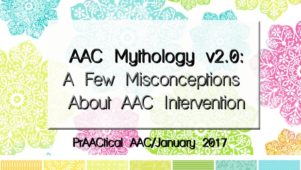
The good news is this: A growing number of people with complex communication needs are getting access to AAC. Educators whose students had AAC only at circle and snack time are now using it more consistently with their students throughout the day and teaching lessons specifically designed to build skills with AAC systems. SLPs who had eschewed AAC or who had focused their AAC efforts on choicemaking, requesting, and labeling are now embracing their role as language specialists and teaching a fuller array of semantic, morphological, and syntactic skills to AAC learners. AT specialists who had been doling out the same few SGDs and AAC apps are now digging deeper and using established practices for AT selection in supporting minimally verbal and nonverbal students. Behaviorists who had previously focused primarily on receptive identification and verbal imitation are supporting the expressive needs of their clients in new ways. Families who had little... [Read More...]
November 25, 2016
by Carole Zangari -

Helping families build their AAC support skills is an important part of what we do. In today’s post, we have a return visit from Alicia Garcia, a lead SLP at the AAC Clinic at One Kids Place, a children’s treatment centre in northern Ontario. Alicia has more than two decades of clinical experience in a variety of settings and locales. You can see a guest post Alicia did on avoiding pitfalls in aided language input here. Today, she shares a booklet of handouts on AAC facilitation skills that can be used when working with families and other stakeholders. Many thanks to the AAC Team at One Kids Place for allowing us to share this helpful resource.
October 3, 2016
by Carole Zangari -
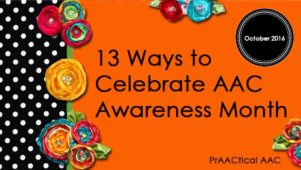
Need some ideas for celebrating AAC Awareness Month? Here are a few to get you started. Participate on the #USSAAC Twitterchat on 10/13 at 7:00 pm EDT (UTC−04:00). New to Twitterchats? You can learn more here. The wonderful Chris Bugaj will be moderating. Subscribe to a blog with an AAC content, such as Uncommon Sense, Jane Farrall Consulting, AAC Girls, or Superpower Speech Follow a new AAC topical Pinterest board from Lauren Enders and others: AAC and AT, AT/AAC/Adapt/Modify/Accessibility/Accommodations, AT for Communication, SLP AAC, & AugComm, AAC by Constantly Speaking, Communication-AAC Print, hang, or give someone an AAC awareness image, 10 Commandments of AAC Devices, or 5 Tips for Communicating with Nonverbal Student Register for a free AAC professional development webinar from Ablenet University Print out an AAC Poster, like Lauren Enders’ AAC Boot Camp-Getting AAC Users to Communicate or Kate Ahern’s The Periodic Table of AAC, Explore an AAC app or SGD that is new to you Print out song visual... [Read More...]
September 19, 2016
by Carole Zangari -

Our Site of the Month addresses a topic relevant to many of you who serve AAC learners. The Project Core website is the public face of a research project looking at the use of an AAC intervention program that uses a consistent set of core vocabulary that grows with the learner over time. The multi-tiered system for augmenting language used in this project begins with extensive aided language input and explicit instruction of selected core words during meaningful interactions throughout the school day. This forms a foundation on which more specialized and individualized intervention and vocabulary selection is built. The project is part of the Center for Literacy and Disability Studies at the University of North Carolina at Chapel Hill where the team has been developing a classroom-friendly intervention approach based on the System for Augmenting Language that was pioneered in the 1990s and continues to build an evidence base... [Read More...]
September 7, 2016
by Carole Zangari -
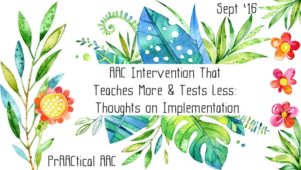
In an earlier post, I shared a graphic on the ways that AAC skills are ‘taught’ versus ‘caught.’ Teaching AAC skills involves the use of specific instructional strategies that give learners information and experiences which result in them being able to communicate more effectively. In many instances, we set out to do just that, but end up with an interaction that ‘catches’ what the student already knows how to do, rather than helping them gain additional skills. There are a few important concepts here. They both have an important role. ‘Catching’ skills isn’t bad. We can do this to figure out what the learner already knows/can do, and give him/her practice with the skill so that it becomes faster and easier to produce. When our interactions ‘catch’ a skill, we’ve created (or taken advantage of) an opportunity for communication. That’s important BUT, it isn’t teaching them anything new. Our learners do... [Read More...]
July 27, 2016
by Carole Zangari -
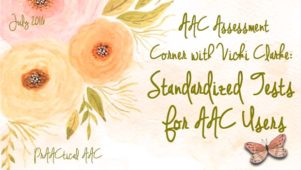
Do you have a love-hate relationships with formal testing? Are you required to use normed tests with your minimally verbal clients? Looking for recommendations on which tests to use? AAC specialist Vicki Clarke has you covered! Like many of you, I’ve had mixed feeling when it comes to using normed assessment instruments with my AAC learners, particularly when we needed to modify the test materials or administration procedures in order for them to be able to participate and respond. If the client can’t point to pictures, give a verbal response, or sit through an entire test, we have no choice but to adapt how the test is administered. As we all know, when we adapt test materials (e.g., putting the test items on an eye gaze board) or procedures (e.g., partner-assisted scanning), we lose the ability to use the normative data. We can, though, compare our learners to themselves at... [Read More...]
June 30, 2016
by Carole Zangari -
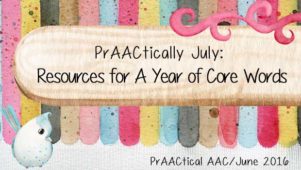
Keiran has a new AAC app that is well-populated with core vocabulary. Gabbie has had an SGD for awhile but doesn’t use it as frequently as her team had hoped. Hudson is transitioning from PECS to an AAC device with more robust language. While different in many ways, each of these learners has a common need: frequent opportunities to learn about and use core vocabulary. To accomplish this, their SLPs, teachers, and families select a dozen or so core words and pay special attention to those each month. That allows them to highlight this small group of words using focused language stimulation, aided language input, and specific activities designed to teach or practice them. In previous years, we shared lists of some core words to help you do just that. Set 1 (2013: A Year of Core) (12 words/month) Set 2 (2014: Another Year of Core) (16 words/month) In today’s post,... [Read More...]
June 20, 2016
by Carole Zangari -
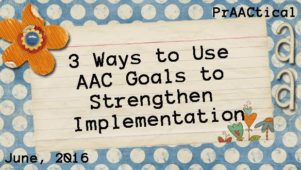
Concerned about AAC systems not being implemented as often as they should? Looking for ways to help AAC learners gain additional practice? Trying to help colleagues build the habit of actively supporting AAC learners? You are not alone. There are several strategies to boost the use of AAC, and adding some key phrases to the goals we write is one of them. Here are some thoughts on ways to use goals to strengthen the day-to-day AAC experiences of the learners with whom we work. Aided Language Input: Experienced AAC professionals and knowledgeable families understand that consistent use of this strategy is the most powerful way to build AAC use. If this is an issue for your AAC teams, consider adding verbiage to the goals that mandate the use of this strategy. Examples: “Given consistent AAC modeling, ___ will…” “When provided with aided language input, ___ will…” Frequent Implementation: Like many... [Read More...]
May 19, 2016
by Carole Zangari -
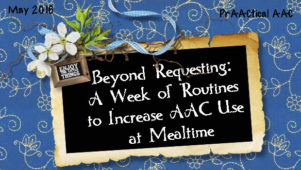
“Waffle.” “I want ___.” “More.” “I’d like a diet coke, please.” “Help.” Most AAC interventionists are quite effective at helping clients use their communication systems during snack or mealtime in order to make requests. How can we move beyond that and help AAC learners communicate for a wider variety of purposes? Mealtimes are wonderful social opportunities and we can take advantage of that by building interaction opportunities around predictable routines. Why build a routine? The predictability helps learners understand what is expected of them. Understanding the expectation sets the stage for active participation. When something becomes a routine, it gets implemented regularly. That gives our learners lots of opportunities to practice their new skills. It also gives us the opportunity to get better at key instructional strategies, such as aided language input, creating explicit opportunities, and using language expansions. Need some suggestions for routines that can be created to foster... [Read More...]









